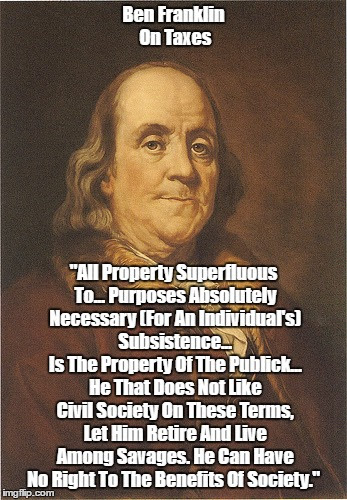
Ben Franklin On "No New Taxes"
When the 29-year-old Charles Darwin made his endearing list of the pros and cons of marriage, he was applying a now common decision-making technique pioneered half a century earlier by another revolutionary mind on the other side of the Atlantic: America’s polymathic Founding Father Benjamin Franklin (January 17, 1706–April 17, 1790).
Not since the Stoics had there been so prolific a prophet of self-improvement as Franklin.
From the list of thirteen virtues he penned when he was only twenty to his staggering daily routine to his clever trick for disarming haters, he continually devised and applied various psychological frameworks to just about every problem of existence. By middle age, Franklin’s reputation as a formidable sage of practical wisdom rendered him on the receiving end of countless pleas for advice, many of which he generously and thoughtfully obliged.

Benjamin Franklin (Portrait by David Martin, 1767)
In the late summer of 1772, Franklin received one such plea from a friend — the English scientist, theologian, and liberal political theorist Joseph Priestley, at the time working as minister of the famed Unitarian church Mill Hill Chapel in Leeds. On Franklin’s recommendation, the Earl of Shelburne had offered the 39-year-old Priestley a lucrative position as his general assistant, tasked with managing his library and educating his children. Priestley was torn — the appointment would grant him financial stability for the first time in his life and would leave ample time for his scientific investigations, but it would require that he relinquish his ministry and move his family to the Earl’s estate near Bath. Unsure how to proceed, he turned to Franklin for help in navigating the high-stakes conundrum.

Joseph Priestley (Portrait by Ellen Sharp, 1794)
Rather than telling his friend what to choose, Franklin taught him how to choose. His letter, cited in Steven Johnson’s excellent book Farsighted: How We Make the Decisions That Matter the Most (public library), outlined a sort of worksheet for the moral mathematics of decision-making — the first known instance of a pros and cons framework.
Franklin writes:
In the Affair of so much Importance to you, wherein you ask my Advice, I cannot for want of sufficient Premises, advise you what to determine, but if you please I will tell you how.
When these difficult Cases occur, they are difficult chiefly because while we have them under Consideration all the Reasons pro and con are not present to the Mind at the same time; but sometimes one Set present themselves, and at other times another, the first being out of Sight. Hence the various Purposes or Inclinations that alternately prevail, and the Uncertainty that perplexes us.To get over this, my Way is, to divide half a Sheet of Paper by a Line into two Columns, writing over the one Pro, and over the other Con. Then during three or four Days Consideration I put down under the different Heads short Hints of the different Motives that at different Times occur to me for or against the Measure. When I have thus got them all together in one View, I endeavour to estimate their respective Weights; and where I find two, one on each side, that seem equal, I strike them both out: If I find a Reason pro equal to some two Reasons con, I strike out the three. If I judge some two Reasons con equal to some three Reasons pro, I strike out the five; and thus proceeding I find at length where the Ballance lies; and if after a Day or two of farther Consideration nothing new that is of Importance occurs on either side, I come to a Determination accordingly.And tho’ the Weight of Reasons cannot be taken with the Precision of Algebraic Quantities, yet when each is thus considered separately and comparatively, and the whole lies before me, I think I can judge better, and am less likely to take a rash Step; and in fact I have found great Advantage from this kind of Equation, in what may be called Moral or Prudential Algebra.
Priestley accepted the position, which proved to be a turning point in the history of science. Less than three years later, in the laboratory the Earl of Shelburne built for him, he went on to conduct the famous experiment in which he focused the sun’s rays on a sample of mercuric oxide through a burning glass and discovered oxygen, O2 — a new kind of air Priestley marveled was “five or six times better than common air for the purpose of respiration, inflammation, and, I believe, every other use of common atmospherical air.”
Complement this particular fragment of the altogether insightful Farsighted with Descartes on the cure for indecision, Milan Kundera on knowing what we really want, Nobel-winning psychologist Daniel Kahneman on how our intuitions mislead us, and Oliver Burkeman on the psychology of why overplanning and excessive goal-setting limit our happiness and success, then revisit Franklin on the truest source of happiness.
No comments:
Post a Comment